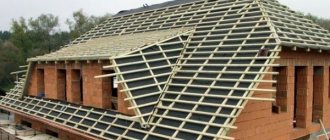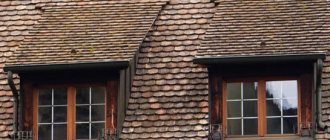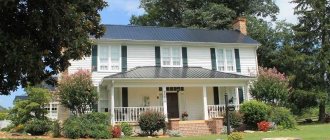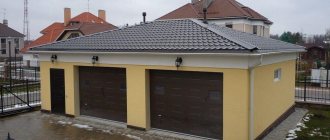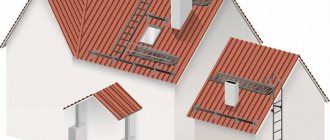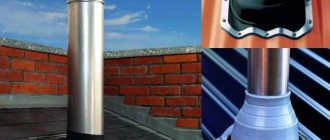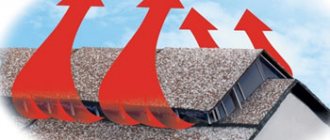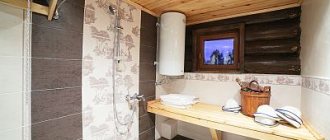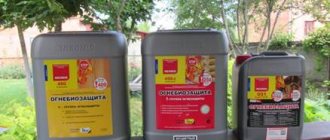0
7035
02.09.2014
From the first days of the origin and development of architectural and construction art in the history of mankind, two trends in arranging roofs for buildings and structures appeared: pitched volumetric and flat horizontal. And if flat roofs initially became widespread mainly in southern Mediterranean and Asian countries, then vertical pitched roofs - in northern European countries and Russia.
Roofing materials for flat roofing
The explanation for this is quite simple and pragmatic: the roof must provide reliable waterproofing of the home and withstand the load of precipitation accumulating on it. In southern countries with a lot of sunny days, this problem is not so acute and there, as a rule, they choose the least expensive flat roof option. In northern countries, a pitched roof is a necessary measure, although it is more expensive during the construction process.
Requirements for roofing
The outer layer of the cake of such designs should:
- Be as tight as possible (ideally seamless) and resistant to atmospheric and external influences, including UV radiation, moisture, temperature changes and mechanical loads. The latter is especially true for exploited flat roofs, which are subject to intensive wear due to constant mechanical stress.
- Comply with fire safety standards.
- Maintain its beneficial properties for at least 4-5 years, preferably more.
External attractiveness plays a role only when arranging used and green roofs; in other cases, the type of covering can be any. In addition to performance indicators, important selection criteria include the cost of materials and the simplicity of their installation technology; when doing work on your own, preference is given to types that can be installed without the use of special equipment.
Rolled, sprayed and coating materials based on bitumen and polymers, specialized roofing membranes and multi-layer composite coatings have suitable characteristics.
It is important to realize that traditional roofing materials that have proven themselves in covering low-slope slopes (flexible tiles, ondulin, seam) on flat roofs are installed with restrictions or a number of additional conditions. In particular, they require continuous flooring, waterproofing carpet or reinforced joint sealing.
Combining with the above materials is possible, but it is not economically profitable (the attractiveness of flexible tiles or seams on ordinary flat slopes is not noticeable, and these types are not designed for pedestrian and transport loads). Rigid grades of corrugated sheeting often serve as a base rather than an external covering.
Content
Materials for roofing a flat roof cannot be selected based on the principle of “relevance in the new season.” All sorts of fashionable ondulins and flexible tiles are not suitable. And here's why: despite their decorative properties and undeniably good performance when working on pitched roofs, they are not capable of forming a continuous moisture-resistant carpet. And this is how a flat roof should be: absolutely sealed, with a minimum of seams - to ensure that moisture cannot seep under the layers of the roofing pie.
The following options are suitable:
- bitumen roll materials;
- polymer membranes;
- mastics.
All these coatings in the roofing carpet are dense enough to provide good waterproofing of a flat roof, and elastic enough to normally withstand temperature and mechanical influences. Moreover, each material has its own characteristics - in terms of functionality, installation method, durability, cost. Therefore, if you are planning to cover a flat roof, but do not yet know what, then we suggest that you familiarize yourself with the characteristics of the main materials.
Laying methods
Conventionally, all materials suitable for flat roofs are divided into roll and liquid; if necessary, both types are combined. At the moment, mechanically fastened systems are inferior to glued, fused and liquid-dispensed materials that form continuous coatings with a minimum number of seams.
Welded
This group is represented by bitumen, polymer and mixed types of roll materials mounted on bases after heating the lower layers to 200 °C. Heating is carried out using gas burners, special attention is paid to work safety. The method is valued for its simplicity, speed and reliability; the only disadvantages include limitations when working with flammable substrates.
Find out how to make a built-up roof with your own hands from the video:
Self-adhesive
“Cold” safe fixation of rolled materials is carried out in two ways: by coating the panels with adhesive mastics and installing self-adhesive marks after removing the protective film. The first method is possible only if the glue and the roll coating are fully compatible, the second is recognized as more convenient and effective. But for obvious reasons, self-adhesive coatings are more expensive.
Self-leveling and spraying
Liquid compositions are optimal when it is necessary to obtain a seamless pie, but on exploited flat roofs they are not used as an independent coating.
Materials are applied with a roller, brush or using special equipment, the latter is expensive and is available only to professional teams.
Features of a flat roof
In Russia, until some time ago, flat roofs were intended only for industrial buildings or multi-story buildings.
But recently, with the development of construction technologies, flat roofs have begun to be used for individual residential buildings. This became more evident after all restrictions on area and number of floors in private housing construction were lifted.
Today, when creating a cottage project, the second or third floor is already designed. And on the resulting horizontal roof area you can safely place a resting place, a greenhouse or a fitness area. All these advantages contribute to the high growth in popularity of flat roofs, and new technologies and roofing materials will simplify and reduce the cost of the construction process, providing it with high strength, durability and reliability.
The main advantage of a flat roof is its simplicity and low cost. Investments in a flat roof are determined mainly by the costs of insulating the upper floor and ensuring high-quality waterproofing.
Kinds
The range of coatings for flat roofs is constantly growing, including through the improvement of traditional roll materials or the combination of different types of coatings. Top sales are headed by bitumen and polymer materials that are as resistant to moisture as possible.
Bitumen rolls
This group is represented by durable roll coatings impregnated with modified or oxidized bitumen, with dimensions ranging from 1-1.2 m in width and up to 30 m in length. Depending on the material and structure of the base, the following types are distinguished:
- Ruberoid is a budget coating based on bitumen-impregnated cardboard with a non-flammable mineral bedding on the outside.
The advantages of this material are well known - roofing felt is cheap, airtight and easy to install. But due to their low resistance to temperature changes, coatings based on roofing felt have a limited service life (5-10 years), after which the roof must be renewed. The average price of a 1×15 m roll is 490 rubles. - Rubemast is an improved version of roofing felt with a thicker layer of bitumen on the bottom side and a reinforced topping layer on the outside. The coating is installed hot, the durability of the fused carpet reaches 15 years. Starting prices for a roll of 10 m² are 530 rubles.
- Stekloizol - durable, flexible, heat- and wear-resistant coatings, reinforced with glass cloth or fiberglass, protected on the outside with polymer films or coarse-grained non-flammable bedding. The coating is hot-fused onto flat roofs and retains its useful properties for up to 20 years at a material price of 70 rubles/m².
- Euroroofing material is a modern coating impregnated with modified bitumen, characterized by increased flexibility and resistance to moisture and any external influences. But despite all the advantages, compared to conventional brands, euroroofing material costs 2-3 times more.
Polymer membranes
This type of coating for flat roofs appeared on the market relatively recently, but quickly gained top positions.
This is explained both by the variety of sizes (membrane width reaches 20 m, length - 60, if desired, the entire plane is covered in a single piece) and unique characteristics (durability up to 30-50 years, increased elasticity and strength, ability to remove condensate at almost 100% tightness, reinforcing and self-supporting properties).
Installation is carried out mechanically or by diffusion soldering; a number of roofing membranes can easily withstand direct backfilling with gravel or other ballast.
The assortment is presented:
- Membranes based on rubber reinforced with polyester fibers and fiberglass. On sale there are both regular EPDM membranes and combined grades with a bottom layer of bitumen-polymer mixture, sold at a price of 290 rubles/m².
- PVC varieties , represented by membranes with different shades and thicknesses with a cost of 280 rubles/m². PVC membranes look attractive and are characterized by increased strength and resistance to stress. The repair-free service life reaches 20-30 years, after which the coating fades, but can maintain integrity and tightness.
- TPO membranes based on thermoplastic rubber and polypropylene with modifying additives that improve resistance to UV, aggressive environments, low temperatures and wear. This type of roofing membrane is recommended for installation in northern latitudes or under unfavorable operating conditions. Starting price – 285 rubles/m².
From the video you will learn about the technology of installing PVC membranes on a flat roof:
Liquid and coating mastics
Bitumen, polymer and combined mastics are applied to the base in liquid form and are considered the best option when it is necessary to lay a seamless coating.
In addition to forming the main protective layer, mastics are actively used in repairing or sealing flat roofs and are combined with other materials (namely, with reinforcing and bulk layers). But they are most often not compatible with hot-fused roll coatings.
The advantages of mastics include elasticity, absence of seams, withstand temperature changes ranging from -50 to +120 ° C (for some brands - up to 200), strength and wear resistance (maximum when combined with reinforcing canvases), good resistance to moisture and precipitation.
The disadvantages are manifested in the relatively low UV resistance (following the norms, mastic surfaces are covered with protective paints every 2-3 years or covered with gravel) and the dependence of the tightness of the formed layer on the quality of the base and the evenness of the mastic distribution. Areas with thinner carpet will deteriorate and leak faster.
The best reviews in this group are from Technonikol mastics (Eureka No. 41, Technomast No. 21, No. 33 and No. 31, AquaMast).
With an average consumption of 2-4 kg/m² (from 6 for multilayer systems), processing costs vary from 60 to 200 rubles/m². Savings are possible when purchasing large volumes of mastic in bulk.
Here's a quick reminder of the pros and cons of each material
• PVC membrane - perhaps the most durable of the single-ply membranes with a lifetime warranty, but also very expensive; • EPDM - affordable, but not as durable as PVC; • TPO is an energy efficient membrane, but the new technology requires experienced contractors; • modified bitumen - multi-layered, but also heat-absorbing and difficult to install; • BUR is a good choice if the building can withstand a heavy load; • spraying onto the coating is a seamless option, but expensive.
To find the perfect flat roofing material, you really need to consider the most common problems your roof will face. Of course, you will also have to consider your budget.
What is better to choose for outbuildings and a private house?
There is no optimal material in terms of price and durability; the decision is made based on the purpose of the flat roof.
There is no point in covering the surfaces of secondary buildings (for example, a garage, barn) with expensive membranes or euroroofing felt. Fused roll materials, such as roofing felt, are quite suitable for these purposes.- When arranging the roofs of residential buildings and industrial buildings, the situation is the opposite, since the requirements for withstanding loads will be much greater. For these purposes, it is better to use modern membrane roofing or mastics.
In general, when carrying out work on your own, preference is given to built-up bitumen or combined coatings, mechanically laid membranes or mastics. With an unlimited budget and increased requirements for withstanding loads, polymer membranes connected by diffusion win.
One-story houses made of SIP panels with an exploitable roof
A feature of SIP panels is their low level of strength, so it is necessary to carefully calculate the resulting load on the walls. Thus, one-story houses are the most in demand from this material. Practical slabs are mounted on a frame, the external cladding is made of almost any material, the main thing is that it protects the building from weather conditions. The durability of the structure depends on compliance with the installation technology.
To summarize, it is worth saying that houses with a flat, usable roof are very functional and attractive . The opportunity to create additional space for relaxation, entertainment, and sports means a lot to any owner of a country cottage.
Using the advice and recommendations of expert Alexander Zemskov in this video, you can correctly and efficiently make a roof that is in use.
How to cover the roof?
Regardless of the type of coating chosen, work begins with the formation, strengthening and preparation of the base. At the initial stage, the surfaces are inspected for defects, cleaned of debris and old, leaky layers (if any), dried, primed or impregnated with soil.
Note! In some cases, the base needs to remove concrete deposits, leveling, forced heating or drying.
Welded roll
Laying is carried out in dry, low-wind weather at an air and base temperature of +5° (if this condition is violated, gas consumption on the burner increases or the quality of adhesion deteriorates). Further:
- In addition to the standard preparation of the base, before installing the surface-surface coatings, sanding of the vertical adjacent sections and arrangement of fillets is carried out.
- Starting from the lower sections of the flat roof, the first lining layer is laid with a mandatory extension of at least 15 cm onto the walls. The entire roll is rolled out, the edges and the bottom layer are heated with a burner, after which the covering is pressed tightly to the base with a roller.
- The second and subsequent panels of the first row are laid with a 10 cm overlap at the joint. Each strip is glued after checking the quality of adhesion of the previous seam; areas at the junction should not peel off or bubble.
- With the joint offset, the second and subsequent layers of the overlay coating are installed.
A similar procedure is followed when attaching a built-up roll roofing over old coatings. The differences appear only in preparation: all peeling and bubbling areas are removed without regret, and all old layers are well dried.
Important: when working with wooden bases, the first layer is attached using other methods, without heating the coating with a burner!
Learn about the design and features of installing a flat roof on wooden beams from this article.
Mastic
The procedure depends on the type of roof: reinforced, unreinforced and combined soft roofs have a different number and sequence of layers. In any case, work is carried out in dry weather, after cleaning and priming the base. If there are lining layers (the most common cake scheme), step by step:
- Areas adjacent to the parapet and walk-through vertical structures are protected.
- A lining layer of rolled perforated fiberglass is laid on a flat and clean base.
- Mastic is spread over the lining in an even layer (if necessary, after heating). The composition should completely saturate the glass sheet through the holes and harden. Some manufacturers offer the opposite procedure, namely, applying hot mastic to the base and then covering it with rolled reinforced canvas.
- The vapor barrier layer and insulation are being installed. After this, the cake is covered with another layer of mastic and a waterproofing carpet.
The above scheme is not universal and changes when working with wooden bases (board decks are covered with bitumen cardboard and reinforced with wire mesh and only then covered with mastics and rolled materials), laying a cast unreinforced pie (a continuous layer of bitumen-latex mastic with the addition of mineral or gravel chips is distributed on the base ).
In general, when forming a mastic roof with a slope of 2-10°, at least 3 layers of the composition are distributed over the surface with the addition of 2 layers of reinforcement or 1 gravel.
During all work, the cake is protected from moisture, until all layers of mastic have completely hardened; the exact time is indicated in the manufacturer’s flow chart.
Profiled sheeting
This material is better suited for arranging the bases of a lightweight flat roof than for a finishing coating. The technology for installing such roofs is simple - after fixing the rigid sheets, vapor barrier, insulation and roofing membranes are laid over the waves. To fasten the slabs, disc-shaped dowels are used; in some cases, pieces of insulation are also placed in corrugation (how to make a flat roof for a private house with your own hands, including for a frame house?).
Corrugated sheeting is rarely laid as an external covering (manufacturers set the minimum permissible slope at 11-12°, less often - 8), but such cases do occur. Moreover, of all types of sheet metal materials, corrugated sheeting is better suited for these purposes than others. This is explained by the variety of sizes offered; roofs with a small area can be covered with one sheet up to 12-13 m long.
Discharged sheathing is not allowed; on flat roofs, corrugated sheeting is attached exclusively to a solid deck, with the obligatory coating of the screw-in points of the roofing screws with sealant. This design is better suited for wooden roofs with the insulation hidden inside the pie.
The sheathing under the corrugated sheet must be screwed to concrete bases with anchors; this method is considered inconvenient and is practically not implemented.
Summary of materials
So, all materials were considered. It remains to answer the question of what is the best way to cover a flat concrete roof. It’s probably not worth asking the question so radically. After all, each material and method of covering flat roofs has its own advantages and disadvantages. For example, built-up roofing is the cheapest. But the installation process requires a propane tank and an open flame.
Mastic modifications are easy to use. They are simply applied to the surface in a thin layer. And this is enough to talk about one hundred percent isolation. But this is exactly what everyone strives for when covering roofs with roofing material. But among the three proposed options, mastic is the most expensive.
Corrugated sheeting can also be classified as inexpensive options. It is no more expensive than mastic. But its installation requires additional elements: lathing, screws. At the same time, the process of fastening profiled sheets itself is associated with some fairly stringent requirements:
- screwed in perpendicular to the plane of the roofing material;
- to pinch or under-tighten the fasteners; a hole with low tightness may form, and this is the likelihood of leaks;
- The corrugated sheeting is fastened to the bottom wave .
The corrugated sheeting must be fastened with self-tapping screws into the lower wave. Source tupikov.ru
But we must pay tribute to the fact that corrugated sheeting is a durable material with a long service life, especially for sheets coated with a polymer layer. You can walk on it without any problems, without fear of damaging the coating. In this regard, other materials are not inferior in terms of wear resistance. But it all depends on the intensity of walking. For example, mastic materials do not like mechanical stress.
Water disposal
Flat roofs have a slight slope, so the organization of drainage here is especially important. Drainage can be external or internal. In the first case, water is diverted to drainpipes located along the edges of the roof. In the second, it is collected into special funnel fittings leading to pipes laid inside the building. Both options have their pros and cons. Thus, pipes laid outside must be heated, and the installation of fittings requires increased attention to waterproofing joints in order to prevent leaks.
